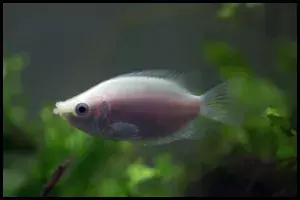
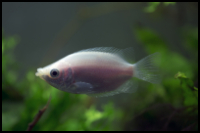
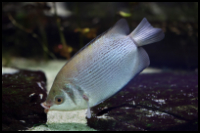

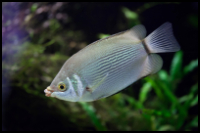
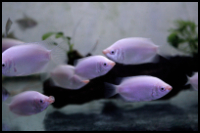
Quick Care Details (Table)
| Livestock Characteristics | Value |
|---|---|
| Care Level | Moderate |
| Temperament | Semi-Aggressive |
| Diet | Omnivore |
| Maximum Size | 12 Inches |
| Minimum Tank Size | 30 Gallons |
| Plant Safe | Yes |
| Temperature Range | 72-82F |
| PH Range | 6.5-8.0 |
| KH Range | 5-20 |
Species Specific Categories
Helpful Video
Care Details
Aquascape
- Provide a well-planted aquarium with a mix of live plants and floating plants.
- Include hiding spots such as rocks, driftwood, and caves for the gouramis to explore.
- Leave open swimming spaces as kissing gourami are relatively large fish and need room to move.
Substrate
- Use a fine to medium-sized gravel or sand substrate.
- Avoid sharp or rough substrates that could potentially injure the gourami's sensitive barbels.
Disease Prevention
- Quarantine new fish before introducing them to the main tank to prevent the spread of diseases.
- Maintain good water quality through regular water changes and proper filtration.
- Avoid overfeeding to prevent excess organic matter from polluting the water.
Filtration
- Use a good-quality filtration system suitable for the tank size and bioload.
- Kissing gourami produce a moderate amount of waste, so adequate filtration is essential.
- Consider a filter that provides biological, mechanical, and chemical filtration for optimal results.
Lighting
- Provide moderate to low lighting for the aquarium.
- Kissing gourami prefer subdued lighting conditions as bright lights can stress them.
- Consider using adjustable LED lights to control the intensity and duration of lighting.
Water Flow
- Kissing gourami prefer slow to moderate water flow.
- Avoid strong currents as it can stress and disorient the fish.
- Adjust the filter output or use baffles to reduce water flow if necessary.
Hardiness
- Kissing gourami are generally hardy and can adapt to a range of water conditions.
- They can tolerate a variety of pH levels but prefer slightly acidic to neutral water (pH 6.0 to 7.5).
- The water temperature should be kept between 75°F to 82°F (24°C to 28°C).
Temperament and Behavior
Behavior and Social Interaction
- Kissing gourami are generally peaceful and social fish.
- They can become territorial during breeding or when kept in small tanks with limited space.
- They may display interesting behaviors, such as "kissing" each other, which is a part of their courtship and social interactions.
Aggression
- While kissing gouramis are mostly peaceful, they can show aggression towards their own species, especially during breeding.
- Males may become territorial and display aggressive behaviors towards other males.
- It's essential to provide ample space and hiding spots to minimize aggression.
Breeding
- Breeding kissing gourami can be challenging and requires specific conditions.
- They are bubble nest builders, and males create elaborate floating nests to attract females.
- The male and female perform a "kissing" ritual as part of their courtship before spawning.
Compatibility
- Kissing gourami are generally compatible with other peaceful community fish.
- Avoid keeping them with aggressive tank mates or fin-nipping species, as their long fins can be targets for aggression.
- They may coexist with other gourami species, but ensure adequate space and minimize territorial disputes.
- Good tank mates would be livebearers, tetra, rasbora, dwarf cichlids, small catfish, other dwarf gouramis.
Activity Level
- Kissing gourami are moderate swimmers and spend a lot of time exploring their surroundings.
- They may be more active during feeding times and social interactions.
- Adequate space and environmental enrichment can encourage their natural behaviors.
Clean up Crew
- Kissing gourami are not typical "clean up crew" fish and do not actively scavenge for leftover food or algae.
- If there is uneaten food or debris in the tank, it's best to use a separate clean up crew like snails or small catfish.
Schooling or Shoaling Behavior
- Kissing gourami do not exhibit strict schooling or shoaling behaviors.
- However, they are social fish and often found in loose groups in the wild.
- In the aquarium, they can be kept as individuals, pairs, or in small groups, but avoid overcrowding.
Diet and Nutrition
Dry Foods
- Kissing gourami can be fed high-quality dry foods like pellets or flakes formulated for omnivorous fish.
- Choose products with a balanced mix of proteins, vitamins, and minerals to meet their dietary needs.
Frozen Foods
- Offer frozen foods like brine shrimp, bloodworms, and daphnia as occasional treats.
- Frozen foods are rich in nutrients and can add variety to their diet.
Live Foods
- Kissing gourami enjoy live foods such as brine shrimp, blackworms, and mosquito larvae.
- Live foods provide essential nutrients and can stimulate natural hunting behaviors.
Vegetables
- While primarily omnivorous, kissing gourami may occasionally nibble on blanched vegetables like spinach or zucchini.
- Vegetables can be offered as supplemental treats but should not be a primary food source.
Algae
- Kissing gourami are not algae eaters, and algae should not be a significant part of their diet.
- However, they may graze on small amounts of algae in the tank.
Feeding Schedule
- Offer small, frequent feedings throughout the day.
- A typical feeding schedule can consist of 2-3 small feedings per day.
- Avoid overfeeding, as it can lead to water quality issues and health problems.
Supplemental Foods
- In addition to their regular diet, you can provide supplemental foods as occasional treats.
- Supplemental foods include live or frozen treats like daphnia, bloodworms, brine shrimp, and blackworms.
Tank Parameters
Tank Size
- Kissing gourami require a minimum tank size of 20 gallons (75 liters).
- Larger tanks are recommended for multiple gouramis and to provide ample swimming space.
Tank Length and Measurements
- For a 20-gallon tank, typical dimensions could be around 24 inches (61 cm) in length, 12 inches (30 cm) in width, and 16 inches (41 cm) in height.
- Tank measurements can vary based on the specific tank model and manufacturer.
The Species Maximum Size
- Kissing gourami (Helostoma temminckii) can reach a adult maximum size of about 12 inches (30 cm).
- In captivity, they often grow to around 8 to 10 inches (20 to 25 cm).
Water Temperature
- Kissing gourami prefer a tropical water temperature range of 75°F to 82°F (24°C to 28°C) in your aquarium.
- Maintaining the water temperature within this range is important for their overall health of your fish in the aquarium.
pH (Acidity/Alkalinity)
- The recommended pH range for kissing gourami is slightly acidic to neutral, around 6.5 to 7.5 in your tank.
- Keeping the pH level stable within this range helps to prevent stress on the fish in your tank.
KH (Carbonate Hardness)
- The recommended carbonate hardness (KH) level is around 2 to 8 dKH (35.7 to 142.9 ppm) in your tank.
- Carbonate hardness helps stabilize the pH level and buffer against rapid pH fluctuations for your aquarium.
GH (General Hardness)
- The general hardness (GH) level should be around 5 to 15 dGH (89.5 to 267.9 ppm) in your tank.
- GH refers to the concentration of dissolved minerals in the water for your aquarium.
Nitrate (NO3) Levels
- Kissing gourami are sensitive to high nitrate levels, which can negatively impact their health.
- Aim to keep nitrate levels below 20 ppm in your tank, and regular water changes can help achieve this.
History, Popularity, History and Species Variety Details
History and Popularity
Kissing Gouramis (Helostoma temminckii) have a rich history and have garnered popularity among aquarists worldwide. Native to Southeast Asia, particularly Thailand, Malaysia, Indonesia, and surrounding regions, they inhabit slow-moving rivers, streams, and flooded areas. Their striking appearance and unique behaviors have made them a sought-after species in the aquarium hobby.
The history of Kissing Gouramis can be traced back to the mid-19th century when they were first introduced to the Western world. They were initially described scientifically in 1840 by the Dutch ichthyologist Coenraad Temminck, who named the species after himself. Since then, they have been selectively bred and distributed globally, becoming widely available in the aquarium trade.
Kissing Gouramis are renowned for their distinctive mouth structure, which gives them their name. Their lips are thick, fleshy, and extend outwards, resembling puckered lips ready for a kiss. This unique feature, coupled with their gentle and curious nature, has captivated the interest of aquarium enthusiasts.
In the wild, Kissing Gouramis play a significant ecological role. They are known to feed on algae, detritus, and small invertebrates, contributing to the balance of aquatic ecosystems. However, their popularity in the aquarium trade has led to increased demand for captive-bred specimens.
Their peaceful temperament and relative ease of care have contributed to their popularity among hobbyists. Kissing Gouramis are generally compatible with a wide range of peaceful tankmates, and their distinctive appearance makes them an attractive addition to community aquariums. However, it is important to note that they can display territorial behaviors, especially when breeding or establishing their personal space.
The popularity of Kissing Gouramis can also be attributed to their interesting behaviors. They are known for their "kissing" behavior, where two individuals face each other and press their lips together, creating a vacuum-like sound as they suck in air. This behavior is believed to be a display of dominance or courtship and adds an element of intrigue to their care.
In terms of care, Kissing Gouramis require a suitable environment that replicates their natural habitat. They prefer a well-planted aquarium with ample hiding spots, as well as open swimming spaces. Water parameters should be maintained within acceptable ranges, including stable pH, temperature, and appropriate hardness levels.
Over the years, advancements in breeding techniques have led to the availability of various color variations and morphs of Kissing Gouramis. These include different shades of pink, red, or albino variations, which have further contributed to their popularity among aquarium enthusiasts.
Other Types of Dwarf Gourami
- Powder Blue Dwarf Gourami (Trichogaster lalius "powder blue"):
- This variety has a striking powder blue coloration with a hint of iridescence.
- Males often display brighter colors with vertical stripes on their bodies.
- Flame Dwarf Gourami (Trichogaster lalius "flame"):
- The Flame Dwarf Gourami features vibrant red-orange coloration, resembling flames.
- Males typically have more intense colors, especially during courting or when displaying.
- Neon Blue Dwarf Gourami (Trichogaster lalius "neon blue"):
- As the name suggests, this type showcases a vibrant neon blue hue.
- It's known for its electric blue appearance, which is more pronounced in males.
- Sunset Dwarf Gourami (Trichogaster lalius "sunset"):
- The Sunset Dwarf Gourami has a beautiful combination of orange and pink colors.
- Males may exhibit more intense colors, especially when trying to attract females.
- Honey Dwarf Gourami (Trichogaster chuna):
- Also known as the Thick-Lipped Gourami, this species is closely related to the dwarf gourami.
- It has a more elongated body shape and a honey-golden coloration.
- Neon Yellow Dwarf Gourami:
- This variety displays a bright neon yellow color, creating a striking appearance in the aquarium.
Male gender vs Female gender (Sexual Dimorphism)
- Body Shape: Male Kissing Gouramis tend to have a more elongated and slender body shape compared to females, which are generally rounder and fuller in the abdominal region. This difference becomes more evident as they mature.
- Dorsal Fin: Males typically have a longer and more pointed dorsal fin compared to females. The dorsal fin of females is usually shorter and more rounded.
- Pectoral Fins: Male Kissing Gouramis often have more extended and more pointed pectoral fins compared to females, which have shorter and rounder pectoral fins.
- Anal Fin: The anal fin of male Kissing Gouramis is usually longer and more pointed compared to the female's anal fin, which tends to be shorter and more rounded.
- Coloration: In some cases, male Kissing Gouramis may exhibit more vibrant and intense coloration compared to females. However, this can vary among individuals, and coloration alone may not be a definitive gender indicator.
Breeding the Kissing Gourami
- Set up a Breeding Tank: Prepare a separate breeding tank that is spacious and well-equipped. It should ideally be around 30 gallons in size or larger. Provide suitable hiding spots using live plants, PVC pipes, or other decorations.
- Select Breeding Pair: Choose a mature male and female Kissing Gourami for breeding. Look for individuals that display optimal health, vibrant colors, and suitable body shape.
- Conditioning Period: Prior to breeding, it's beneficial to condition the breeding pair with a nutritious and varied diet. Offer high-quality foods, including live or frozen foods, to enhance their overall health and reproductive readiness.
- Adjust Water Parameters: Create optimal breeding conditions by adjusting the water parameters in the breeding tank. Maintain a temperature of around 80°F (27°C), slightly acidic to neutral pH between 6.0 and 7.5, and moderate hardness levels.
- Stimulate Breeding Behavior: To encourage breeding behavior, replicate natural conditions by gradually increasing the temperature of the breeding tank by a few degrees. Perform partial water changes with slightly cooler water to simulate seasonal rainfall.
- Provide Nesting Material: Kissing fish are bubble nest builders. Introduce floating plants like Indian almond leaves, foam or plastic spawning mops, or a styrofoam cup with a small opening to create a suitable surface for the male to build a nest.
- Courtship and Nest Building: The male will initiate courtship behavior by displaying vibrant colors, extending his fins, and circling the female. He will then create a bubble nest at the water's surface, incorporating plant material and air bubbles.
- Spawning: Once the nest is built, the male will entice the female to approach it. During spawning, the pair will embrace, swim together, and release eggs and milt. The eggs will float up into the bubble nest, and the male will collect and guard them.
- Remove Female: After spawning, it's crucial to remove the female from the breeding tank to prevent her from eating the eggs. Place her in a separate tank with suitable conditions and provide her with ample rest and nutrition.
- Incubation and Fry Care: The male will guard the bubble nest and tend to the eggs. After approximately 24 to 48 hours, the eggs will hatch into fry. Initially, the fry will stay in the bubble nest and feed off their yolk sacs. Once they become free-swimming, usually after a few days, the male should be removed from the tank to avoid predation on the fry.
- Feeding the Fry: Feed the newly hatched fry with infusoria, commercially available liquid fry food, or crushed and powdered dry foods specially formulated for small fry. As they grow, gradually introduce baby brine shrimp, micro worms, or other suitable live or frozen foods.
- Fry Tank Maintenance: Conduct regular water changes and monitor water parameters to ensure optimal conditions for the fry. Maintain suitable temperature, water quality, and appropriate feeding schedules to promote their growth and development.
Frequently Asked Questions
How large do Kissing Gourami grow?
Kissing Gourami can grow up to 12 inches (30 cm) in length, although they are typically smaller in home aquariums, reaching around 8 to 10 inches (20 to 25 cm) on average.
Are Kissing Gourami aggressive?
Kissing Gourami can be territorial and may display aggression, especially towards other fish that intrude upon their space. However, their aggression is generally milder compared to some other Gourami species.
Can Kissing Gourami be kept with other fish?
Kissing Gourami can be kept with other peaceful, similarly-sized fish that can tolerate their occasional territorial behaviors. Avoid housing them with fin-nipping or aggressive species.
Do Kissing Gourami require a planted tank?
While not essential, Kissing Gourami appreciate a well-planted tank. Live plants provide hiding spots, shade, and a more natural environment for them. It's best to choose robust plants that can withstand their nibbling.
What should I feed my Kissing Gourami?
Kissing Gourami are omnivorous. Offer a balanced diet consisting of high-quality dry flakes or pellets, supplemented with live or frozen foods like brine shrimp, bloodworms, and daphnia. Include some plant matter as well.
Can Kissing Gourami species be kept in a community tank?
Kissing Gourami can be kept in community tanks with compatible tank mates, provided there is enough space and hiding spots. Avoid housing them with fin-nippers or aggressive fish species.
Do Kissing fish make sounds?
Yes, Kissing Gourami are known for producing audible "kissing" sounds. These sounds are actually produced by the fish sucking in air from the water's surface and then expelling it.
Can Kissing Gouramis breathe atmospheric air?
Yes, Kissing Gouramis have a specialized labyrinth organ that allows them to breathe air from the water's surface. They can obtain oxygen from both water and air, which is an adaptation to their native habitat.
Are Kissing Gouramis a good pet for beginners?
Kissing Gouramis can be suitable for aquarists with some experience. They require proper tank setup, water parameters, and attention to their territorial behaviors. Beginner aquarists should research and understand their care needs.
Do Kissing Gouramis change color?
Kissing Gouramis can exhibit color changes based on their mood, health, or breeding status. They may display more vibrant colors when they are comfortable and during courtship displays.

